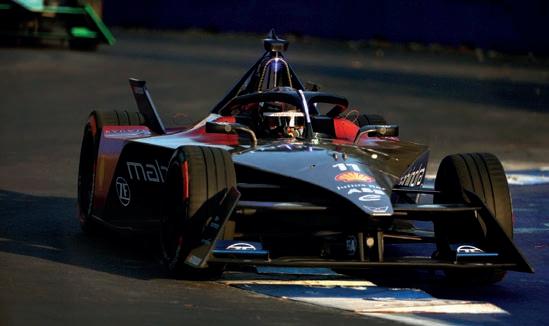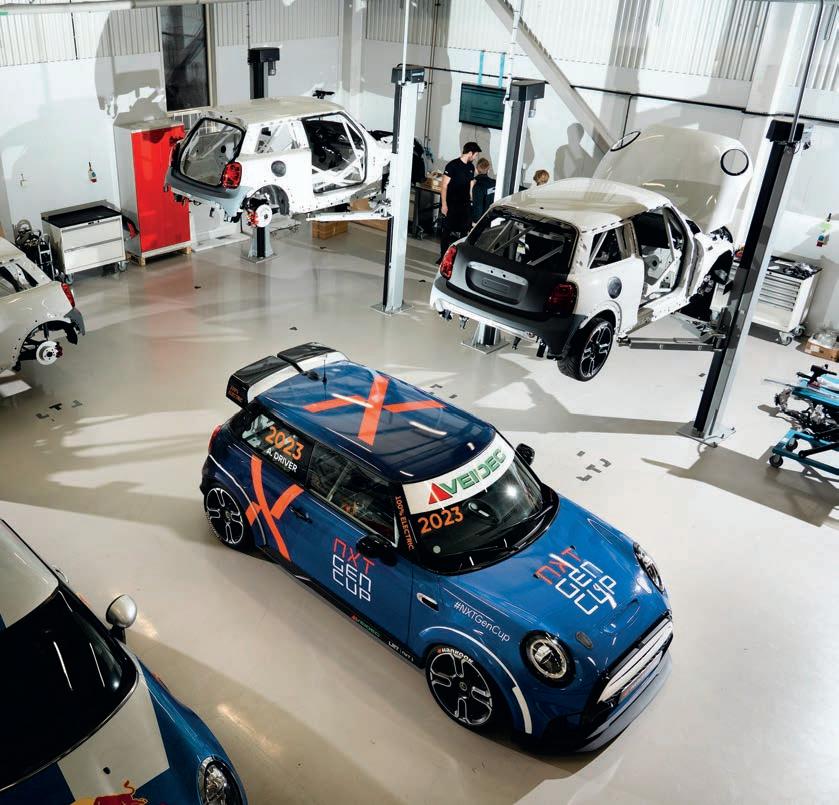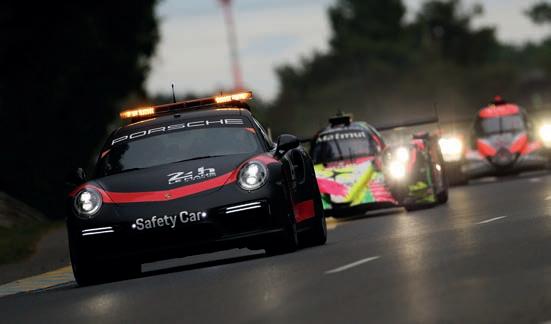
7 minute read
Designed to perform



By STEWART MITCHELL
















Selecting the potent, roadgoing Camaro ZL1LE as the base car from which to develop the Stock Car was driven by close scrutiny and understanding of NASCAR’s design parameters. It doesn’t harm that it’s also Chevy’s archetypal blue collar car, with a huge and loyal worldwide following
The 2022 NASCAR season saw the implementation of the sport’s most significant technical overhaul since its inception. The development of the so-called Gen 7 (2022-present) cars saw thousands of hours of design and testing work over several years, making its debut at the Sun, LA Memorial Coliseum in February that year.
General Motors’ brand, Chevrolet, continued its long-standing commitment to competing in NASCAR into this new generation and its director of NASCAR programmes, Eric Warren, coordinated the Gen 7 Camaro NASCAR ZL1 design effort, as well as its ongoing development.
Warren has been working in NASCAR for over 25 years. Over this time, there have been several significant evolutions of the technical rule book. However, he notes that Gen 7 represents the most momentous shift towards an OEM car design NASCAR has seen in recent history.
Primary driver
‘The primary driver for the new generation of NASCAR Cup cars came from the teams keen to reduce the competition’s running costs,’ says Warren. ‘Secondly, the manufacturers were eager to have a stronger identity connection between the racecars and their road car counterparts.’
The Gen 7 cars introduced a symmetrical body, four-way adjustable independent suspension, a sealed underbody, 18in wheels, rack and pinion steering and a sequential gearbox, along with various other lesser elements. The result is a car that is a far cry from the asymmetric Gen 6 and others that preceded it, which saw historic technology such as beam rear axles and no underfloor aerodynamic features. ‘NASCAR, the teams and the vendors spent a lot of time conducting a cost study to figure out the most cost-efficient way of producing the components, while maintaining a product worth racing and that was attractive and exciting for the teams to run from an engineering perspective,’ notes Warren. ‘The implemented regulations would see more adjustment variables in the Gen 7 car than had ever appeared on a NASCAR Cup car before it to open the scope for a more detailed set-up.
‘The four-way adjustable independent suspension means a much more accurate set-up for the car. There’s been a lot to learn for the teams running these cars throughout 2022, but it’s made for an exciting season for all the competitors.’
Camaro choice
Chevrolet decided its Gen 7 NASCAR would be based on the latest high-performance version of Camaro, the ZL1LE. According to Warren, the choice was as much a technically strategic move as it was a marketing one.

‘The Gen 7 body silhouette changed the shape of the car quite dramatically compared to the previous generation car, going from a saloon to a coupé body shape.
‘We had to be selective, making the NASCAR look like a road car as much as possible, but that selection needed to give us the opportunity to also make it performant.
‘We made sure it was going to be technically advantageous when building the racecar body, and selecting the Camaro was driven by understanding NASCAR’s design parameters, submission and testing process.’
All the OEMs worked on the design and submission process together, and NASCAR lays out an explicit sequence for qualifying the car’s aerodynamic behaviour in the wind tunnel, but really understanding it and being able to plan the scope for developing the car body to extract performance was critical.
‘As we [GM] developed the car, we were aware of what it would achieve in the submission process,’ says Warren. ‘Within the available performance window, we hit it at the right corner of the box that you want to be in. We are in the lowdrag, high-downforce corner of the box, and let’s just say that others are not.’
NASCAR rules specify a series of standard design dimensions and parts across the car. Around the wheel openings, the lower part of the splitter, the side skirts and the tail is a band that is common across all cars. These areas are the most aerodynamically sensitive, and in previous generations were subject to a lot of tweaking and bending by teams in a bid to find a competitive advantage.
‘Overlaying the production Camaro onto the common elements, we took some of the constraints from the NASCAR rulebook and worked with the GM design team to shape the Camaro into the so-called greenhouse silhouette,’ explains Warren. ‘Though the production Camaro ZL11LE does have some downforce-generating features that are performant for on-track running, the requirements for NASCAR are very different.’
GM’s engineering group and marketing departments went back and forth on several occasions, trying to find a compromise that would suit both parties and be performant, as Warren recalls.
‘We [the racing department] wanted to lower the nose and change the tail geometry to work in our favour. And, although the car body is symmetrical, we still wanted to develop as much side force as possible when it goes into yaw.
‘We did a lot of work on these features to make them follow the lines and geometry of the Camaro road car as close as possible at a visual level, but there are detailed elements of the NASCAR body that don’t much follow, which help with its aerodynamic efficiency in racing.’
Force of nurture
‘If you set the Chevrolet NASCAR Gen 7 side by side with a street Camaro ZL1LE, they are impressively close. So, from that standpoint, it’s been very successful, but there was a lot of give and take with the features you can see on the NASCAR vs the production car.’
NASCAR’s aerodynamic regime is unique with the size, shape and number of cars competing in extremely close proximity at the speeds they run. In previous generations, the cars featured a live rear axle and truck arm suspension forcing designers to open the underbody, which made controlling the under-car aerodynamics and the wake size very challenging.
‘In the past, we used to run the front of the car as low as possible to seal off the underside for aerodynamic reasons,’ highlights Warren. ‘Teams would spend a lot of time and money developing the components underneath the car to make them as flat as possible, to aid the mass flow of whatever air did make its way under the body.’
No stone was left unturned. Teams modified everything they could, including the bottom of the engine, steering and lower control arms and suspension components. Anything exposed to the under-floor flow was developed for aerodynamic gains. While the outer surfaces of the Gen 6 cars were carefully controlled, clever teams would engineer their chassis to flex in a certain way under load to work the aerodynamics most effectively. There were considerable aerodynamic gains to be made using this technique.
In some extreme cases, teams would throw away the chassis after each race and build a new one for the upcoming race because of this deliberate induced flexing. Some teams had as many as 16 cars in their fleet and would pick the ones best suited to each individual circuit, or rebuild and develop tailored versions for specific races.

‘Some deemed this extreme over engineering and expensive operation necessary to be competitive in the previous regime,’ says Warren. ‘So, a primary target for the Gen 7 car was to decrease the wake size, ensure the cars could race closer together in the standard package, and remove some of the costs incurred to be competitive.’
Bringing the teams up to speed to understand the under-floor flows with a closed underbody and diffuser was a big task.
Ground control
‘The new cars reward running the diffuser as close to the ground as possible,’ explains Warren. ‘This is a huge departure from what we had always done in this sport.
‘We adjust the ride height at the front and back of the car for the aero balance now, which we never did before because we didn’t have this tuneability before. Understanding the attitude of the car and the ride heights you want has been a huge effort, combining ride height mapping and suspension choice.












‘The tyre / body interaction is another new and challenging development route we are on now. Understanding them is tough as each OEM is limited to just 300 hours in the wind tunnel, and the CFD is also tightly regulated.’
With the Gen 7 body shape, car-to-car interaction is now noticeably different.
Traffic critical
‘Setting up the car to get the behaviour you want when going through traffic is more critical now because you don’t have those same aerodynamic forces you relied on before,’ continues Warren. ‘Multi-car interaction is the focus of our CFD work, and heavy instrumentation for track running – for what testing we get – is essential.’
Real-world telemetry validates the computation work, helping teams understand the behaviour of the cars when passing each other. Teams then develop aerodynamic maps to dial their cars in best to deal with it.
As the lead car runs in clean air, it ends up with more downforce than the cars behind it.
‘It’s easy to get slightly offset from a vehicle in front of you,’ notes Warren. ‘The Gen 7 bodies are affected slightly less by this offsetting influence on the car, so the racing can be tighter.’
Because many elements of the Gen 7 car are spec and can’t be modified, the art of assembling the car is about finding the parts with the closest tolerances that make for the best fitment. Make no mistake, ensuring every tolerance is in your favour is an effort that all the OEMs and teams are putting in under the new Gen 7 regime.
The mass and track width of the car are the same as the Gen 6 version, but the suspension and tyres are different, which leads to different vehicle dynamics. Teams used to rely on the side force and yaw moment of the car to stabilise it on track at high speed, but this doesn’t work with a symmetrical body. Drivers must now rely on set-up to find the corner entry stability they need.
‘Developing a set-up philosophy with the new cars was a learning curve, especially with the rear suspension,’ says Warren. ‘Trading off aerodynamic stability for mechanical stability for corner entry is a hard compromise to strike.
‘This generation of NASCAR sees vast amounts of data coming off the car,’ Warren continues. ‘Teams also have access to data from the other manufacturers, and this is vital to understanding the Chevrolet cars, the enemy, and finding ways to get ahead.’

The data coming from these cars include traces from GPS, throttle, brakes and steering. Teams then compute the metrics and embed them into simulations that consider the track, its surface model and conditions in great detail.
Development path
‘From these simulations, we can understand the car’s capability and know where one competitor has an advantage over the other to help guide us on what development path to take. We combine that with different machine learning and AI technology approaches to correlate the simulator and digital twin simulations as fast as we can to try to gain, or maintain, an advantage.’










